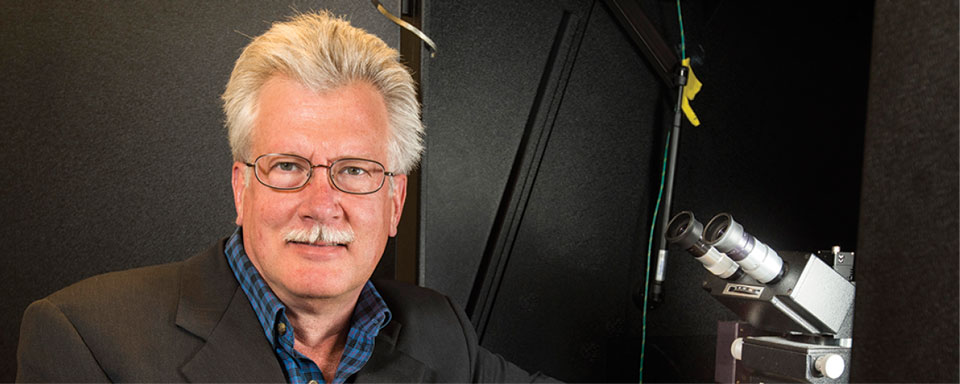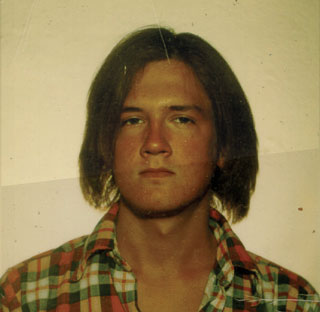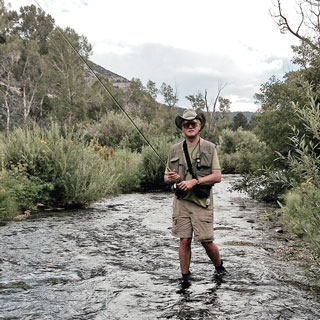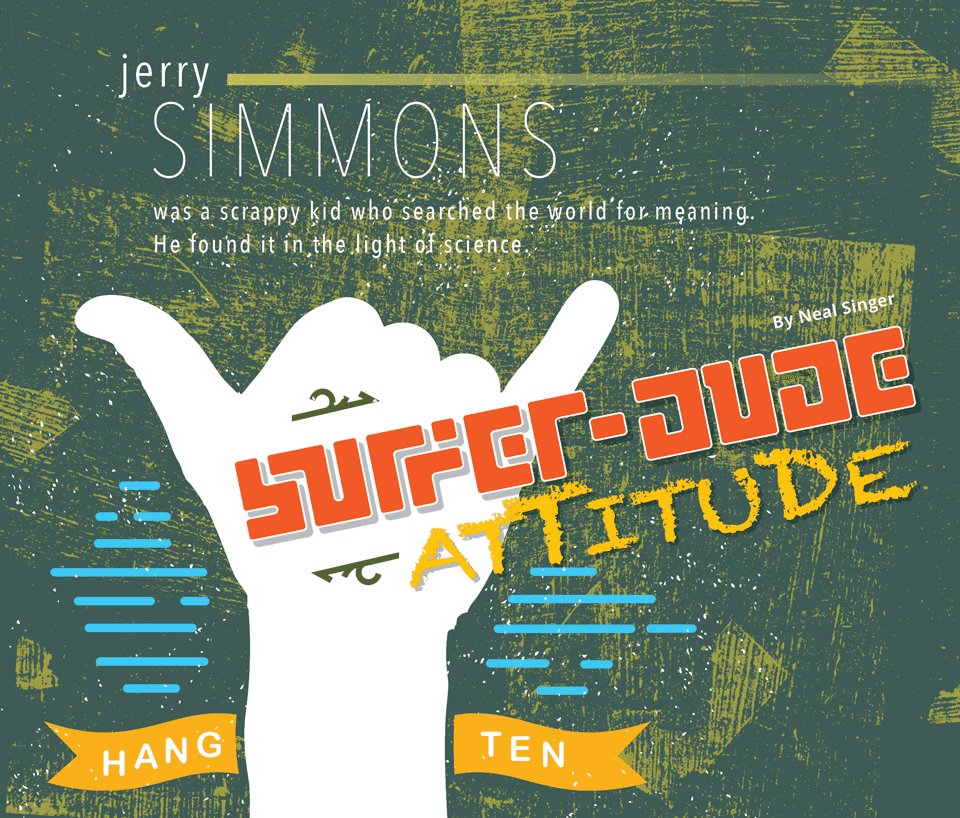Jerry Simmons was a scrappy kid who searched the world for meaning. He found it in the light of science.


Jerry Simmons holds the title of Sandia Fellow, a rarely bestowed honor, but he never received a high school diploma.
These contradictory facts signal why his story might be less an ordinary narrative than (in lights) “The Jerry Simmons Story”: how a neglected waif became — like a galaxy coalescing from thinly dispersed gasses into stars — a Fellow of the American Physical Society and of the American Association for the Advancement of Science, a member of several National Academy of Sciences committees and a main research coordinator for Sandia’s Laboratory Directed Research and Development (LDRD) program.
Simmons displayed unusual curiosity as a child. When he was 2½, his mother let him ride his new tricycle out front while she worked in the kitchen. Soon a lady came knocking, Simmons in tow. She found the energetic boy pedaling furiously five blocks away. Asked where he was going, Simmons told her he “wanted to see what was out there.” Fortunately, he remembered his address.
He did star-quality math and science his first three years of high school in Santa Barbara, California, surfing when he could and hitchhiking home so his then-divorced mom could pursue her Ph.D. But his rough-hewn travel mode made it impossible to participate in the extracurricular activities essential to winning the National Merit Scholarship for which his test scores made him eligible. He decided high school wasn’t for him and left to spend his senior year “out there” in New York City, signing up at the New School for Social Research in a program for kids without high school degrees.

He completed the year, which met freshman college requirements, but Simmons never received his high school diploma because of a bureaucratic glitch. Undeterred, the following year found him enrolled in Trinity College in Wales, Great Britain. The college bore no relation to the intellectual meccas of Trinity Cambridge or Trinity Dublin with which the youthful Simmons had associated it. Trinity of Wales was run by an Iowa farmcountry college with strict rules about how homework was submitted. Simmons was more concerned with content.
Hells Angels for neighbors
Licking his wounds and no longer sure college was for him, Simmons hitchhiked around Europe then retreated to the New School for another year, renting a small Lower East Side apartment next to the Hells Angels motorcycle club, whose late-night parties made sleep problematic.
His universe began coalescing when he found the New College of Florida, a respected college with few require-ments, no grades and a high percentage of students
who go on to graduate school. Over three years, Simmons authored two senior theses – the first on linguistic philosophy, the second on solid-state physics.
Regarding philosophy, Simmons says, “The time I spent learning to reason abstractly and express myself in a logical way has been extremely beneficial to my career.” He studied how language shapes and is inextricably linked to the structure of ideas — “the sexy philosophy of the 20th century. Maybe if Einstein had spoken Hopi, he would have had an easier time with the concept of time.”
The physics thesis, on amorphous silicon semiconductors, resulted from American Physical Society internships at Xerox and the University of Chicago, where he learned about silicon. “I was going to pursue astronomy in grad school, but I was malleable — putty in their [UC’s] hands,” he jokes. “They probably thought it a victory to rescue me from the clutches of the astronomers.”

Simmons was hired as a technician by Bell Labs, where future Nobel laureate Dan Tsui was in the process of moving to Princeton. Simmons went with him, and under Tsui’s tutelage, earned his Ph.D. in electrical engineering in 1990, the same year he took a job at Sandia. He quickly rose from researcher to senior manager, doing specialty assignments along the way.
“The reason I went into management is that I’d been building up a team to work on quantum transport and nanoelectronics, but it couldn’t get bigger than a two-person staff if led by a single researcher,” he says. “There needed to be a manager working to build it as a top priority. I thought I could do that if I took over management of my department. And I did.”
An effortless cordiality
“He works very hard,” says former Sandia acting VP Julia Phillips. “He’s always looking for the best science ideas and the best scientists to bring into a program.”
At a celebration for Simmons’s 20th year at Sandia, director Charles Barbour mentioned the variety of his work, including quantum computing and solidstate lighting, saying, “He works hard and tirelessly. The [research and financial] trend is always up, thanks to Simmons’ work.”
A humorous view of Simmons’ verbal skills in convincing researchers to work on important projects was expressed by colleague Jeff Tsao, a co-leader with Simmons in Sandia’s national solid-state lighting effort, which Simmons helped found: “I tried to remember all the words Simmons used that I didn’t know, but because I didn’t know them, I realized I couldn’t remember them. And when you don’t know the word, you just nod your head, not realizing what you’ve just agreed to.”
Simmons projects an effortless cordiality — a “surferdude attitude,” says his wife Carolyn — but he succeeds because he knows what he wants. “I sit on four LDRD committees, chair two of them and judge Grand Challenge proposals at the same time I help nucleate teams to work on them,” he says.
He helped found one of Sandia’s 11 long-term Research Challenges. “It ’s called Power on Demand, and I’m pretty excited about it,” he says. It brings together three groups of researchers — in electronics, batteries and photovoltaics — to make lighter and smaller radiation-hard electrical power systems that harvest, store and/or convert electricity for a given mission need.
A key challenge is to get researchers in different fields to talk to each other or, as Simmons puts it, “why would transistor guys talk to battery guys?”
If anyone can encourage them to do so, it ’s Simmons. The uncertainty of his chaotic early years has faded away; the warmth of his family and plaudits of his colleagues lend him an increased persuasiveness.
And he’s persistent.
When he got his engineering Ph.D. from Princeton, for example, he called yet again to see if his high school would see the wisdom of awarding him his diploma. They suggested he take the GED exam.
And he intends one day to return to Wales, site of his nonproductive college year, to hike a thousand miles around that country’s border. Asked why, he says, “Well, I like to hike. It ’d be pretty. And I want to see what ’s out there.”
Semiconductors
Semiconductors have revolutionized our lives. The first ones to be well studied were germanium and silicon, and what we learned led to the invention of the transistor at Bell Labs in the 1940s.

But silicon was not the end of the story. Researchers moved on to other semiconductor families, and each time they made discoveries that produced new applications. An example is gallium arsenide, which made possible the high-frequency communications that underlie smart phone technologies. Another is gallium nitride, without which today’s super-efficient, light-emitting diode (LED)-based, solid-state lighting would not have been possible.
What will be the next family of semiconductors to provide revolutionary technologies for our children? A small community of researchers is looking at extreme-gap semiconductors, or ultra-wide-bandgap materials, which were previously seen as insulators incapable of performing any electrical function. Examples are aluminum nitride, gallium oxide and even diamond. It might be possible to create extreme ultraviolet LEDs and lasers, or develop high-speed power transistors cable of handling 100,000 volts and higher for the nation’s electrical grid. But to do this, fundamental questions need answers: How do we grow these extremely hard materials? How do we handle atomic lattice mismatch? How can we “dope” them with impurities to get both negative (electrons) and positive (holes) charge carriers?